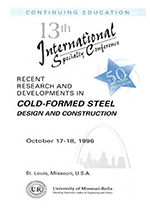Session Dates
17 Oct 1996
Abstract
Southern Africa has a dire need for housing small industries and people, and concomitantly the creation of employment. It is common to use hot-rolled steel sections for industrial structures, which are pre-manufactured and then bolted together on site. In this paper an alternative structural concept for low-rise portals for light industries is proposed, whereby the total frame is made up of standard cold-formed sections which are cut and welded together on site. The cladding material is employed as an integral structural component through the principles of stressed skin diaphragm action. A short pile footing is proposed to provide a degree of rotational fixity for the colunns of the frame. Different frame configurations are investigated and the practical application of the concept is discussed.
Department(s)
Civil, Architectural and Environmental Engineering
Research Center/Lab(s)
Wei-Wen Yu Center for Cold-Formed Steel Structures
Meeting Name
13th International Specialty Conference on Cold-Formed Steel Structures
Publisher
University of Missouri--Rolla
Document Version
Final Version
Rights
© 1996 University of Missouri--Rolla, All rights reserved.
Document Type
Article - Conference proceedings
File Type
text
Language
English
Recommended Citation
van Rensburg, B. W. J. and de Vos, G. P., "Lower Cost Lightweight Cold-formed Portal Frames" (1996). CCFSS Proceedings of International Specialty Conference on Cold-Formed Steel Structures (1971 - 2018). 2.
https://scholarsmine.mst.edu/isccss/13iccfss/13iccfss-session5/2
Lower Cost Lightweight Cold-formed Portal Frames
Southern Africa has a dire need for housing small industries and people, and concomitantly the creation of employment. It is common to use hot-rolled steel sections for industrial structures, which are pre-manufactured and then bolted together on site. In this paper an alternative structural concept for low-rise portals for light industries is proposed, whereby the total frame is made up of standard cold-formed sections which are cut and welded together on site. The cladding material is employed as an integral structural component through the principles of stressed skin diaphragm action. A short pile footing is proposed to provide a degree of rotational fixity for the colunns of the frame. Different frame configurations are investigated and the practical application of the concept is discussed.



